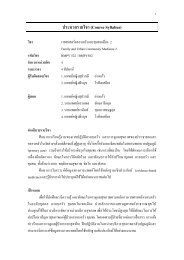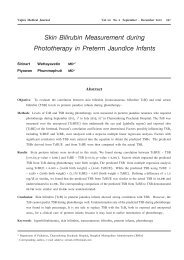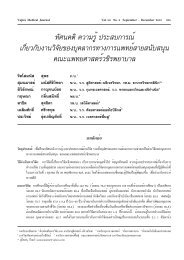Use of oral glucose tolerance test in early pregnancy to predict late ...
Use of oral glucose tolerance test in early pregnancy to predict late ...
Use of oral glucose tolerance test in early pregnancy to predict late ...
- No tags were found...
You also want an ePaper? Increase the reach of your titles
YUMPU automatically turns print PDFs into web optimized ePapers that Google loves.
doi:10.1111/j.1447-0756.2007.00693.x J. Obstet. Gynaecol. Res. Vol. 34, No. 3: 331–336, June 2008<strong>Use</strong> <strong>of</strong> <strong>oral</strong> <strong>glucose</strong> <strong><strong>to</strong>lerance</strong> <strong>test</strong> <strong>in</strong> <strong>early</strong> <strong>pregnancy</strong> <strong>to</strong><strong>predict</strong> <strong>late</strong>-onset gestational diabetes mellitus <strong>in</strong>high-risk womenChadakarn Phaloprakarn and Siriwan TangjitgamolDepartment <strong>of</strong> Obstetrics and Gynecology, Bangkok Metropolitan Adm<strong>in</strong>istration Medical College and Vajira Hospital,Bangkok, ThailandAbstractAim: To evaluate if any s<strong>in</strong>gle plasma <strong>glucose</strong> level from the four values <strong>of</strong> the normal 100-g <strong>oral</strong> <strong>glucose</strong><strong><strong>to</strong>lerance</strong> <strong>test</strong> (OGTT) <strong>in</strong> <strong>early</strong> <strong>pregnancy</strong> (20 weeks <strong>of</strong> gestation) could <strong>predict</strong> gestational diabetes mellitus(GDM) diagnosed from a second OGTT <strong>in</strong> <strong>late</strong> <strong>pregnancy</strong> (28–32 weeks).Methods: Glucose levels <strong>of</strong> pregnant women at high-risk for GDM, who had had a normal <strong>early</strong> OGTT, andwho underwent the second <strong>test</strong> <strong>in</strong> <strong>late</strong> <strong>pregnancy</strong>, were studied. Each <strong>of</strong> the four plasma <strong>glucose</strong> values <strong>of</strong> the<strong>early</strong> OGTT was determ<strong>in</strong>ed for sensitivity, specificity, positive <strong>predict</strong>ive value (PPV), and negative <strong>predict</strong>ivevalue (NPV). The receiver operat<strong>in</strong>g characteristic curves <strong>of</strong> these four OGTT values were then constructed t<strong>of</strong><strong>in</strong>d the optimal value <strong>to</strong> <strong>predict</strong> <strong>late</strong>-onset GDM.Results: Of 193 pregnant women who had had a normal <strong>early</strong> OGTT, 154 also had a normal OGTT <strong>in</strong> <strong>late</strong><strong>pregnancy</strong> while 39 had an abnormal <strong>test</strong> and were diagnosed with GDM. Among the four <strong>glucose</strong> values <strong>of</strong>the <strong>early</strong> OGTT, the 1-h value yielded the best diagnostic performance <strong>to</strong> <strong>predict</strong> <strong>late</strong>-onset GDM. Thesensitivity, specificity, PPV, NPV, and area under the curve achieved from its optimal cut<strong>of</strong>f level <strong>of</strong>155 mg/dL (8.6 mmol/L) were 89.7%, 64.3%, 38.9%, 96.1%, and 0.77, respectively.Conclusions: A 1-h <strong>glucose</strong> value 155 mg/dL at the <strong>early</strong> OGTT yielded the best diagnostic performance.However, the low specificity and PPV rendered it suboptimal <strong>to</strong> <strong>predict</strong> <strong>late</strong>-onset GDM. Nevertheless, aconsiderable number <strong>of</strong> high-risk women could avoid the second OGTT <strong>in</strong> <strong>late</strong> <strong>pregnancy</strong> due <strong>to</strong> its highsensitivity and NPV.Key words: gestational diabetes mellitus, high-risk women, <strong>oral</strong> <strong>glucose</strong> <strong><strong>to</strong>lerance</strong> <strong>test</strong>.IntroductionGestational diabetes mellitus (GDM) is one <strong>of</strong> the riskfac<strong>to</strong>rs for maternal and neonatal morbidities. 1–4 Theoptimal screen<strong>in</strong>g and diagnostic approaches for GDMrema<strong>in</strong> controversial s<strong>in</strong>ce there has been no availabledata from well-designed studies. 1,4–7 The AmericanCollege <strong>of</strong> Obstetricians and Gynecologists recommendeda two-step procedure <strong>to</strong> diagnose GDM. 1 This<strong>in</strong>cludes a 50-g <strong>glucose</strong> challenge <strong>test</strong> (GCT) as an<strong>in</strong>itial screen<strong>in</strong>g step, followed by a diagnostic 100-g<strong>oral</strong> <strong>glucose</strong> <strong><strong>to</strong>lerance</strong> <strong>test</strong> (OGTT) if the screen<strong>in</strong>g GCTis abnormal. 1From the most recent International Workshop-Conference on GDM <strong>in</strong> 1997, the prior recommendation<strong>of</strong> universal screen<strong>in</strong>g was changed <strong>to</strong> a selectiveReceived: May 21 2007.Accepted: September 6 2007.Repr<strong>in</strong>t request <strong>to</strong>: Dr Chadakarn Phaloprakarn, Department <strong>of</strong> Obstetrics and Gynecology, Bangkok Metropolitan Adm<strong>in</strong>istrationMedical College and Vajira Hospital, 681 Samsen Road, Dusit District, Bangkok 10300, Thailand. Email: chadakarn_pt@yahoo.com© 2007 The Authors 331Journal compilation © 2007 Japan Society <strong>of</strong> Obstetrics and Gynecology
C. Phaloprakarn and S. Tangjitgamolapproach. 5 Based on this recommendation, pregnantwomen who are at high risk for GDM should undergoblood <strong>glucose</strong> <strong>test</strong><strong>in</strong>g as soon as possible <strong>to</strong> identifypre-exist<strong>in</strong>g diabetes or <strong>early</strong>-onset GDM, 5 with theaim that an appropriate treatment could be immediatelyemployed <strong>to</strong> optimize the maternal and neonataloutcomes. 8,9 In the circumstance that diabetes is notevident <strong>in</strong> <strong>early</strong> <strong>pregnancy</strong>, blood <strong>glucose</strong> <strong>test</strong><strong>in</strong>gshould be repeated between 24 and 28 weeks <strong>of</strong> gestation<strong>to</strong> detect an event <strong>of</strong> <strong>late</strong>-onset GDM. 5One previous Thai population-based study reportedthat 4.9% <strong>of</strong> high-risk pregnancies for GDM who hadhad normal OGTT <strong>in</strong> <strong>early</strong> <strong>pregnancy</strong> would subsequentlybe detected as hav<strong>in</strong>g GDM by their secondOGTT dur<strong>in</strong>g <strong>late</strong> <strong>pregnancy</strong>. 10 This implied that a highpercentage (approximately 95%) <strong>of</strong> women would besubjected <strong>to</strong> the unnecessary second <strong>test</strong>. Hence, an<strong>in</strong>dica<strong>to</strong>r from the first OGTT which could <strong>predict</strong> ahigh or low probability <strong>of</strong> <strong>late</strong>-onset GDM would beuseful <strong>in</strong> cl<strong>in</strong>ical practice. For example, <strong>in</strong>dividualswho are at <strong>in</strong>creased risk for develop<strong>in</strong>g GDM determ<strong>in</strong>edby the first OGTT (despite a normal <strong>test</strong>) wouldbe aware <strong>of</strong> the disorder, be compliant <strong>to</strong> a follow-upvisit, or be cautious with their diet and daily lifestyle;likewise, the second <strong>test</strong> might be omitted <strong>in</strong> those whoare at lesser risk.One earlier report proposed that the comb<strong>in</strong>ed use <strong>of</strong>fast<strong>in</strong>g and 2-h plasma <strong>glucose</strong> values at specific cut<strong>of</strong>flevels from a normal 75-g OGTT <strong>in</strong> <strong>early</strong> <strong>pregnancy</strong>could exclude women <strong>in</strong> the high-risk group who wereunlikely <strong>to</strong> develop GDM <strong>in</strong> <strong>late</strong> <strong>pregnancy</strong>. 11 However,those values could not be utilized <strong>in</strong> a sett<strong>in</strong>gwhere a 100-g OGTT is used. Thus, this study wasdesigned <strong>to</strong> <strong>in</strong>vestigate whether any s<strong>in</strong>gle plasma<strong>glucose</strong> level from the four values <strong>of</strong> a normal 100-gOGTT <strong>in</strong> <strong>early</strong> <strong>pregnancy</strong> could <strong>predict</strong> the probability<strong>of</strong> abnormal second OGTT (GDM) dur<strong>in</strong>g <strong>late</strong> <strong>pregnancy</strong><strong>in</strong> high-risk women.Materials and MethodsThis study was conducted after approval from theBangkok Metropolitan Adm<strong>in</strong>istration Ethics Committeefor research <strong>in</strong>volv<strong>in</strong>g human subjects. Obstetriccharts <strong>of</strong> women who attended the antenatal cl<strong>in</strong>ic anddelivered at the Department <strong>of</strong> Obstetrics and Gynecology<strong>in</strong> our <strong>in</strong>stitution were reviewed. Dur<strong>in</strong>g thestudy period (1 January 2005 <strong>to</strong> 31 March 2006), allpregnant women without pre-exist<strong>in</strong>g overt diabeteswere screened for GDM with a 50-g GCT due <strong>to</strong> thedepartmental policy. Those without any risk fac<strong>to</strong>rs forGDM were screened between 24 and 28 weeks <strong>of</strong> gestation,while women <strong>in</strong> a high-risk group were <strong>test</strong>ed atan <strong>in</strong>itial visit. High-risk pregnancies for GDM werethose women who had age 35 years, BMI > 27 kg/m 2 , his<strong>to</strong>ry <strong>of</strong> GDM <strong>in</strong> a previous <strong>pregnancy</strong>, familyhis<strong>to</strong>ry <strong>of</strong> diabetes mellitus <strong>in</strong> any <strong>of</strong> first-degree relatives,his<strong>to</strong>ry <strong>of</strong> large neonate (4000 g), his<strong>to</strong>ry <strong>of</strong>adverse per<strong>in</strong>atal outcome (two or more miscarriages,congenital malformation, or stillbirth), or glucosuria.Women who had abnormal GCT results, be<strong>in</strong>g def<strong>in</strong>edas plasma <strong>glucose</strong> levels 140 mg/dL, would bescheduled for a diagnostic 100-g OGTT.A standard OGTT procedure recommended by theAmerican Diabetes Association 12 is rout<strong>in</strong>ely practiced<strong>in</strong> the <strong>in</strong>stitution. In brief, after a 3-day <strong>in</strong>take <strong>of</strong> highcarbohydratefood and an overnight fast for 10–12 h,blood samples at fast<strong>in</strong>g, and three consecutive hourlysamples after the <strong>in</strong>gestion <strong>of</strong> 100 g <strong>glucose</strong> arecollected for plasma <strong>glucose</strong> determ<strong>in</strong>ations. Glucosemeasurements are performed with the <strong>glucose</strong> oxidasemethod us<strong>in</strong>g an au<strong>to</strong>mated analyzer model SynchronLX20 (Beckman Coulter, Fuller<strong>to</strong>n, CA, USA). TheNational Diabetes Data Group (NDDG) criteria areused as the gold standard for diagnos<strong>in</strong>g GDM, whichis made when two or more abnormal <strong>glucose</strong> valuesare identified: fast<strong>in</strong>g value 105 mg/dL (5.8 mmol/L); 1-h value 190 mg/dL (10.5 mmol/L); 2-h value 165 mg/dL (9.1 mmol/L); and 3-h value 145 mg/dL(8.0 mmol/L). 1Eligibility criteria were all high-risk pregnancies forGDM who had had abnormal 50-g GCT, had hadnormal 100-g OGTT <strong>in</strong> <strong>early</strong> <strong>pregnancy</strong> (20 weeks <strong>of</strong>gestation), and underwent a second OGTT dur<strong>in</strong>g <strong>late</strong><strong>pregnancy</strong> (28–32 weeks) between January 2005 andMarch 2006. Women who were lost <strong>to</strong> follow up andthose whose obstetric charts had <strong>in</strong>complete cl<strong>in</strong>icaldata were excluded from the study. Maternal demographicdata, risk fac<strong>to</strong>rs for GDM, gestational ages(GA) at which screen<strong>in</strong>g and diagnostic <strong>test</strong>s were performed,50-g GCT, and all four OGTT values were collected.BMI was calcu<strong>late</strong>d from pre<strong>pregnancy</strong> weight(kg) divided by square <strong>of</strong> height (m 2 ).Statistical analysis was performed us<strong>in</strong>g the spsss<strong>of</strong>tware package version 11.5 (SPSS, Chicago, IL,USA). The stata 7.0 (Stata Corp., College Station, TX,USA) was additionally used <strong>to</strong> generate confidence<strong>in</strong>tervals (CI). Demographic data and <strong>glucose</strong> resultswere presented as mean with standard deviation (SD)or median with range for cont<strong>in</strong>uous variables, and asnumber with percentage for categorical variables. TheStudent’s t-<strong>test</strong> or the Mann–Whitney U-<strong>test</strong> were used332 © 2007 The AuthorsJournal compilation © 2007 Japan Society <strong>of</strong> Obstetrics and Gynecology
<strong>Use</strong> <strong>of</strong> <strong>oral</strong> <strong>glucose</strong> <strong><strong>to</strong>lerance</strong> <strong>test</strong><strong>to</strong> compare cont<strong>in</strong>uous variables as appropriate, andthe c 2 -square <strong>test</strong> was used <strong>to</strong> compare categorical variables.P-value <strong>of</strong>
C. Phaloprakarn and S. TangjitgamolFigure 1 The receiver operat<strong>in</strong>gcharacteristic curves <strong>of</strong> the fourplasma <strong>glucose</strong> values <strong>of</strong> the <strong>oral</strong><strong>glucose</strong> <strong><strong>to</strong>lerance</strong> <strong>test</strong> <strong>in</strong> <strong>early</strong><strong>pregnancy</strong> for the <strong>predict</strong>ion <strong>of</strong><strong>late</strong>-onset gestational diabetesmellitus. The number <strong>in</strong> each l<strong>in</strong>e<strong>of</strong> the receiver operat<strong>in</strong>g characteristiccurves represents theoptimal cut<strong>of</strong>f level (mg/dL) <strong>of</strong>each <strong>glucose</strong> value <strong>of</strong> the <strong>early</strong><strong>oral</strong> <strong>glucose</strong> <strong><strong>to</strong>lerance</strong> <strong>test</strong>.Table 2 Glucose results <strong>in</strong> <strong>early</strong> <strong>pregnancy</strong> <strong>of</strong> 193 high-risk women for gestational diabetes mellitus who develop and didnot develop gestational diabetes mellitus <strong>in</strong> <strong>late</strong> <strong>pregnancy</strong>Total women(n = 193)Women with<strong>late</strong>-onset GDM(n = 39)Women without<strong>late</strong>-onset GDM(n = 154)P-valueGA at GCT (weeks), mean (SD) 12.1 (4.6) 12.1 (4.5) 12.1 (4.6) 0.96†GCT resultPlasma level (mg/dL), median (range) 158 (140–330) 165 (141–265) 156 (140–330)
<strong>Use</strong> <strong>of</strong> <strong>oral</strong> <strong>glucose</strong> <strong><strong>to</strong>lerance</strong> <strong>test</strong>Table 3 Optimal cut<strong>of</strong>f level <strong>of</strong> each <strong>of</strong> the four plasma <strong>glucose</strong> values <strong>of</strong> <strong>oral</strong> <strong>glucose</strong> <strong><strong>to</strong>lerance</strong> <strong>test</strong> <strong>in</strong> <strong>early</strong> <strong>pregnancy</strong> withits diagnostic performance <strong>to</strong> <strong>predict</strong> <strong>late</strong>-onset gestational diabetes mellitusFast<strong>in</strong>g<strong>glucose</strong> value85 mg/dL1-h <strong>glucose</strong>value155 mg/dLOptimal cut<strong>of</strong>f level2-h <strong>glucose</strong>value131 mg/dL3-h <strong>glucose</strong>value98 mg/dLSensitivity (95% CI) 66.7 (60.0, 73.3) 89.7 (85.5, 94.0) 61.5 (54.7, 68.4) 51.3 (44.2, 58.3)Specificity (95% CI) 55.8 (48.8, 62.9) 64.3 (57.5, 71.1) 70.8 (64.4, 77.2) 61.0 (54.2, 67.9)PPV (95% CI) 27.7 (21.4, 34.0) 38.9 (32.0, 45.8) 34.8 (28.1, 41.5) 25.0 (18.9, 31.1)NPV (95% CI) 86.8 (82.1, 91.6) 96.1 (93.4, 98.8) 87.9 (83.3, 92.5) 83.2 (77.9, 88.5)AUC (95% CI) 0.61 (0.52–0.71) 0.77 (0.70–0.85) 0.66 (0.56–0.76) 0.56 (0.46–0.66)AUC, area under the curve; CI, confidence <strong>in</strong>terval; NPV, negative <strong>predict</strong>ive value; PPV, positive <strong>predict</strong>ive value.diagnostic performance <strong>to</strong> <strong>predict</strong> abnormal OGTT<strong>in</strong> <strong>late</strong> <strong>pregnancy</strong>, with its optimal cut<strong>of</strong>f level <strong>of</strong>155 mg/dL. From the statistical po<strong>in</strong>t <strong>of</strong> view, anoptimal <strong>glucose</strong> level <strong>in</strong> this <strong>early</strong> OGTT which yieldeda high specificity would be appropriate <strong>to</strong> identifywomen (with plasma <strong>glucose</strong> levels above the threshold)who were at greater risk for <strong>late</strong>-onset GDM. Onthe other hand, a level with a high sensitivity would bebest <strong>to</strong> exclude women (with plasma <strong>glucose</strong> levelsbelow the threshold) who were unlikely <strong>to</strong> have abnormalOGTT <strong>in</strong> <strong>late</strong> <strong>pregnancy</strong>. At the optimal cut<strong>of</strong>f level<strong>of</strong> 155 mg/dL <strong>of</strong> 1-h <strong>glucose</strong> value, it yielded highfalse-positive rate (low specificity <strong>of</strong> only 64.3%) andpoor PPV <strong>of</strong> 38.9%. These results would render this <strong>test</strong><strong>in</strong>appropriate for an identification <strong>of</strong> women who werelikely <strong>to</strong> develop <strong>late</strong>-onset GDM. In an attempt <strong>to</strong>reduce the number <strong>of</strong> false-positive cases (<strong>in</strong> order <strong>to</strong><strong>in</strong>crease the specificity), we sought <strong>to</strong> determ<strong>in</strong>ethe women’s characteristics, <strong>glucose</strong> levels, and riskfac<strong>to</strong>rs for GDM <strong>in</strong> this particular group <strong>of</strong> women.However, we could not identify any specific featuresuggest<strong>in</strong>g an underly<strong>in</strong>g reason for a false-positiveresult. Its high rate might lie on the small number <strong>of</strong> thestudy population. Based on our observation that the<strong>test</strong> yielded low specificity and poor PPV, we could notrecommend an omission <strong>of</strong> <strong>late</strong> OGTT for high-riskwomen with the 1-h value <strong>of</strong> <strong>early</strong> OGTT 155 mg/dL.On the contrary, the high sensitivity (88.9%) and NPV(96.1%) <strong>of</strong> this method made it suitable <strong>to</strong> be a screen<strong>in</strong>g<strong>test</strong> (for exclud<strong>in</strong>g women with a low probability <strong>of</strong><strong>late</strong>-onset GDM), as only a few GDM women would bemissed. This would also lessen the number <strong>of</strong> womenwho would have <strong>to</strong> undergo the second OGTT <strong>in</strong> <strong>late</strong><strong>pregnancy</strong>.To date, there has been only one report which <strong>in</strong>vestigatedthe diagnostic performance <strong>of</strong> plasma <strong>glucose</strong>values from normal 75-g OGTT <strong>in</strong> <strong>early</strong> <strong>pregnancy</strong>(16 weeks <strong>of</strong> gestation) for a <strong>predict</strong>ion <strong>of</strong> <strong>late</strong>-onsetGDM (24–28 and 32–34 weeks). 11 Bi<strong>to</strong> et al. studied 155high-risk women for GDM and found that a fast<strong>in</strong>g<strong>glucose</strong> level <strong>of</strong>
C. Phaloprakarn and S. Tangjitgamol3. Rosenberg TJ, Garbers S, Lipk<strong>in</strong>d H, Chiasson MA. Maternalobesity and diabetes as risk fac<strong>to</strong>rs for adverse <strong>pregnancy</strong>outcomes: differences among 4 racial/ethnic groups. Am JPublic Health 2005; 95: 1545–1551.4. American Diabetes Association. Gestational diabetes mellitus.Diabetes Care 2004; 27 (Suppl. 1): S88–S90.5. Metzger BE, Coustan DR, The Organiz<strong>in</strong>g Committee.Summary and recommendations <strong>of</strong> the Forth InternationalWorkshop-Conference on Gestational Diabetes Mellitus.Diabetes Care 1998; 21 (Suppl. 2): B161–B167.6. Cosson E, Benchimol M, Carbillon L et al. Universal ratherthan selective screen<strong>in</strong>g for gestational diabetes mellitusmay improve fetal outcomes. Diabetes Metab 2006; 32: 140–146.7. Griff<strong>in</strong> ME, C<strong>of</strong>fey M, Johnson H et al. Universal vs. riskfac<strong>to</strong>r-based screen<strong>in</strong>g for gestational diabetes mellitus: detectionrates, gestation at diagnosis and outcome. Diabet Med2000; 17: 26–32.8. Barahona MJ, Sucunza N, Garcia-Patterson A et al. Period <strong>of</strong>gestational diabetes mellitus diagnosis and maternal and fetalmorbidity. Acta Obstet Gynecol Scand 2005; 84: 622–627.9. Bartha JL, Mart<strong>in</strong>ez-Del-Frezno P, Com<strong>in</strong>o-Delgado R. Gestationaldiabetes mellitus diagnosed dur<strong>in</strong>g <strong>early</strong> <strong>pregnancy</strong>.Am J Obstet Gynecol 2000; 182: 346–350.10. Boriboonhirunsarn D, Sunsaneevithayakul P, Nuchangrid M.Incidence <strong>of</strong> gestational diabetes mellitus diagnosed before 20weeks <strong>of</strong> gestation. J Med Assoc Thai 2004; 87: 1017–1021.11. Bi<strong>to</strong> T, Nyari T, Kovacs L, Pal A. Oral <strong>glucose</strong> <strong><strong>to</strong>lerance</strong> <strong>test</strong><strong>in</strong>gat gestational weeks 16 could <strong>predict</strong> or exclude subsequentgestational diabetes mellitus dur<strong>in</strong>g the current <strong>pregnancy</strong> <strong>in</strong>high risk group. Eur J Obstet Gynecol Reprod Biol 2005; 121:51–55.12. American Diabetes Association. Gestational diabetes mellitus.Diabetes Care 1986; 9: 430–431.13. Fan ZT, Yang HX, Gao XL, L<strong>in</strong>tu H, Sun WJ. Pregnancyoutcome <strong>in</strong> gestational diabetes. Int J Gynecol Obstet 2006; 94:12–16.14. Hanna FW, Peters JR. Screen<strong>in</strong>g for gestational diabetes: past,present and future. Diabet Med 2002; 19: 351–358.15. Agarwal MM, Punnose J, Dhatt GS. Gestational diabetes:problems associated with the <strong>oral</strong> <strong>glucose</strong> <strong><strong>to</strong>lerance</strong> <strong>test</strong>.Diabetes Res Cl<strong>in</strong> Pract 2004; 63: 73–74.336 © 2007 The AuthorsJournal compilation © 2007 Japan Society <strong>of</strong> Obstetrics and Gynecology








